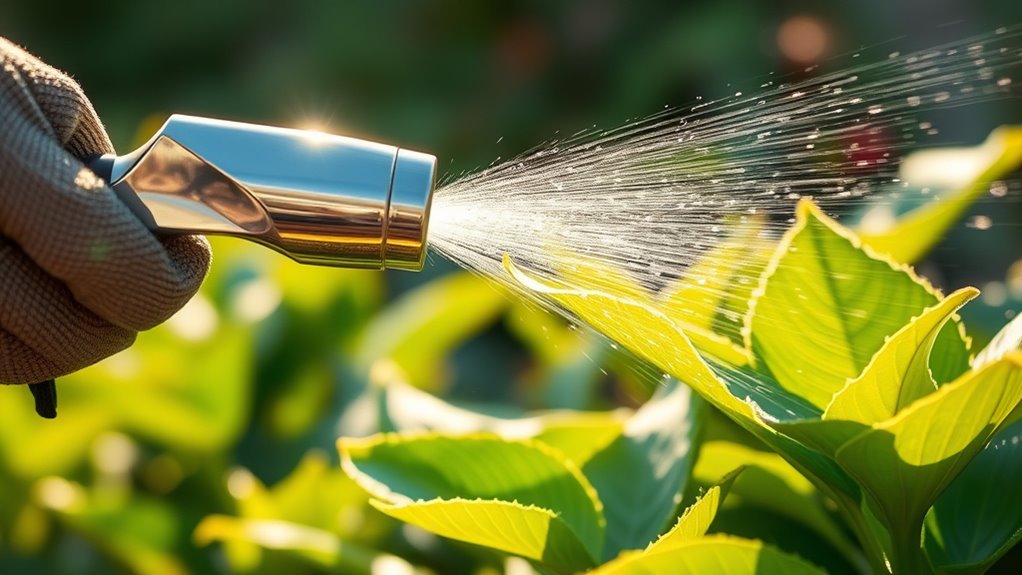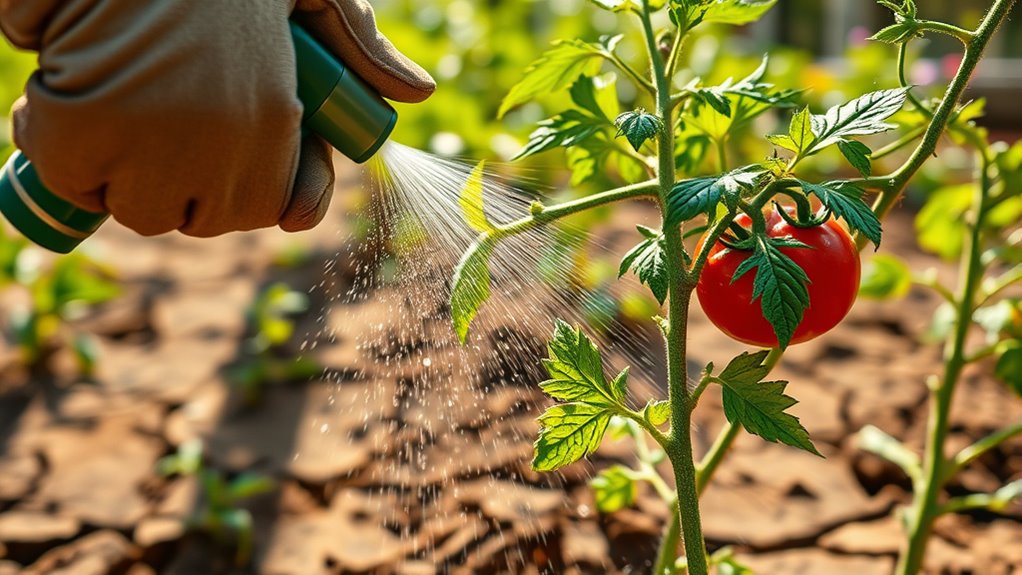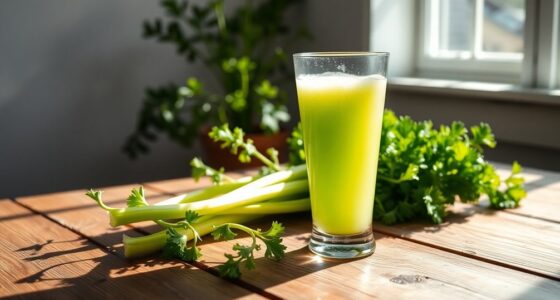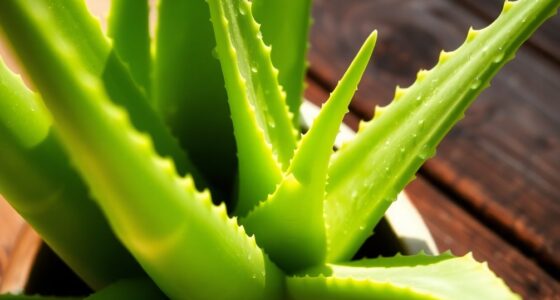During heatwaves, water your plants early in the morning or late in the evening to reduce evaporation and guarantee deep moisture absorption. Use techniques like drip irrigation or soaker hoses for efficient watering, and check soil moisture regularly to avoid underwatering or overwatering. Mulching helps retain moisture and keeps roots cooler. Consistently monitor your plants’ response; if you want to learn more about keeping your garden resilient during extreme heat, keep exploring these tips.
Key Takeaways
- Water early in the morning or late in the evening to maximize absorption and reduce evaporation.
- Deeply water plants once or twice weekly to maintain consistent soil moisture during heatwaves.
- Use drip irrigation and water timers for efficient, targeted hydration.
- Apply mulch around plants to retain soil moisture and keep roots cooler.
- Monitor soil moisture regularly to adjust watering frequency and prevent over- or under-watering.
Understanding Your Plants’ Water Needs

Understanding your plants’ water needs is essential, especially during heatwaves when dehydration risks increase. Soil moisture levels directly influence plant hydration, so it’s important to monitor how wet or dry the soil feels. When soil is too dry, plants struggle to absorb enough water, leading to stress and potential damage. Conversely, overly wet soil can cause root rot and other issues. Check soil moisture regularly by feeling the top inch—if it’s dry, it’s time to water. Recognize that different plants have varying hydration needs; some require frequent watering, while others prefer less. To help your plants thrive, consider using essential oils for plant health, which can support resilience during extreme conditions. Additionally, understanding the importance of soil moisture levels helps you adjust your watering practices more effectively. Regular monitoring of soil moisture is crucial for preventing over- or under-watering. Being aware of plant hydration requirements allows for a more tailored approach to watering. By understanding these needs, you can adjust your watering practices to maintain suitable soil moisture, ensuring your plants stay healthy and resilient during extreme heat.
Best Times to Water During Hot Weather

Watering at the right times during hot weather helps your plants stay healthy and reduces water waste. For ideal timing precision, water early in the morning or late in the evening when temperatures are cooler. This allows plants to absorb moisture more effectively and minimizes evaporation caused by the sun’s heat. Avoid watering during the hottest part of the day, typically midday, as much of the water will evaporate before reaching the roots. This practice enhances drought tolerance, helping plants develop stronger root systems and better withstand dry conditions. Using timing techniques to schedule watering can further improve water efficiency and plant health. Consistent watering schedules aligned with these times ensure your plants stay hydrated without overwatering. Proper watering techniques can also prevent soil degradation and promote healthy root growth. Being aware of evaporation rates during different times of the day can help you fine-tune your watering schedule even further. Additionally, understanding plant water needs can help you adjust your watering habits to ensure optimal growth and resilience during heatwaves.
Techniques for Deep and Effective Watering

To guarantee your plants receive adequate moisture, focus on techniques that promote deep and thorough watering. Using drip irrigation systems ensures water reaches the roots directly, minimizing waste and evaporation. These systems deliver consistent moisture slowly, encouraging roots to grow deeper and stronger. Incorporate water timers to automate watering schedules, preventing overwatering or underwatering during busy periods. Set timers to deliver water early in the morning or late in the evening for ideal absorption. Adjust the drip emitters to provide a steady flow that penetrates the soil without pooling on the surface. Deep watering encourages roots to grow downward, making plants more resilient during heatwaves. Honda Tuning offers insights on how modifications can enhance vehicle performance, which parallels the importance of proper watering techniques in maintaining plant health. Consistent, targeted watering through drip systems and timers keeps soil moist and healthy, reducing stress on your plants during extreme heat. Soil Moisture Management is essential for ensuring that water penetrates deeply enough to sustain plants in high temperatures.
How Much Water Is Enough During a Heatwave

Deep watering during heatwaves means providing enough moisture to keep your plants healthy without overdoing it. You want to maintain consistent soil moisture, ensuring the roots have enough water to thrive. Typically, this means watering deeply once or twice a week, depending on your soil type and weather conditions. Check the soil moisture by feeling the top 2-3 inches; if it feels dry, it’s time to water. Avoid shallow watering, which encourages weak roots, or overwatering, which can lead to root rot. During heatwaves, plants may need more frequent watering, but always monitor soil moisture levels to prevent water waste. Proper watering guarantees your plants stay hydrated, healthy, and resilient against the stress of high temperatures. Regular self-exams can help detect health issues early, similar to how consistent watering helps maintain plant health. Additionally, understanding your soil’s water retention capacity can improve your watering strategy and prevent both drought stress and overwatering.
Using Mulch to Retain Moisture

During a heatwave, applying mulch around your plants is one of the most effective ways to retain soil moisture. Mulch helps lower soil temperature, preventing rapid evaporation and keeping roots cooler. Choose from various mulch types like organic (straw, bark, compost) or inorganic (rubber, gravel). Each type offers different benefits, so select based on your plants’ needs. Proper mulch depth—about 2-3 inches—ensures ideal moisture retention without suffocating roots. Here’s a quick comparison:
| Mulch Type | Benefits | Best Use |
|---|---|---|
| Organic | Improves soil & retains moisture | Flower beds & vegetable gardens |
| Inorganic | Long-lasting, minimal maintenance | Pathways & decorative areas |
| Mulch Depth | 2-3 inches | General moisture conservation |
Using the right mulch enhances water efficiency during extreme heat.
Signs of Underwatering and Overwatering

While mulch helps retain moisture during heatwaves, it’s equally important to recognize when your plants aren’t getting the water they need—or are receiving too much. Signs of underwatering include wilting, dry soil, and shallow root depth, which makes plants more vulnerable to drought stress. Overwatering, on the other hand, causes soil moisture to become excessive, leading to yellowing leaves, root rot, and soggy soil that smells sour. Check your soil moisture regularly; if it feels dry a few inches below the surface, your plants may need more water. Conversely, if the soil is constantly wet, you might be overwatering. Understanding these signs helps you maintain healthy root growth and prevents stress caused by improper watering. Additionally, using a vetted home theatre projector can help you monitor plant growth and health more efficiently indoors, especially during extreme weather conditions. Proper watering techniques, such as avoiding both over- and underwatering, are essential for promoting healthy plant roots and overall plant vitality. Incorporating moisture sensors or electric dirt bikes with advanced features can also assist in precise watering management. Recognizing the importance of consistent moisture levels is supported by studies showing that fluctuating water supply can significantly impact plant health and growth. Implementing automation technology in watering systems can further optimize water use and reduce manual effort.
Adjusting Your Watering Routine as Temperatures Rise

As temperatures rise, you’ll need to water more often to keep your plants healthy. Consider watering early in the morning or late in the evening to reduce evaporation and guarantee your plants absorb the moisture. Adjusting your routine now helps your garden withstand the heat and stay lush. Implementing proper watering techniques can further enhance your garden’s resilience during hot weather. Using self-watering pots can also be beneficial in maintaining consistent moisture levels without frequent watering. Incorporating water retention methods such as mulching can help reduce water loss from the soil surface during the heatwave, supporting your plants’ growth amidst digital distractions that often divert attention from routine gardening tasks. Being aware of vetted Halloween product reviews can help you select the best gardening tools and accessories to facilitate your watering efforts effectively.
Increase Water Frequency
When temperatures climb during a heatwave, you’ll need to water your plants more frequently to prevent stress and dehydration. Increasing watering frequency helps maintain soil moisture levels, which are essential for healthy roots. Use watering tools like hoses or sprinklers that deliver even coverage, ensuring your plants get enough moisture. To keep track, consider this simple schedule:
| Time of Day | Soil Moisture Level | Watering Frequency |
|---|---|---|
| Early morning | Low | Daily or twice daily |
| Midday | Very low | Additional light watering |
| Evening | Adequate | Check soil moisture before watering |
Adjust as needed based on weather and plant response. Regular monitoring of soil moisture levels helps prevent over- or under-watering, ensuring your plants stay healthy throughout the heatwave. Proper watering can also support the health of delicate plant roots, which are more vulnerable during extreme heat conditions.
Water Early or Late
Increasing your watering frequency during a heatwave helps keep soil moist and plants healthy. Timing preferences are vital—watering early in the morning or late in the evening minimizes evaporation and guarantees plants absorb moisture effectively. Adjust your watering schedules based on the heat intensity and plant type.
- Water early to reduce evaporation and maximize soil absorption
- Late watering prevents rapid drying during peak heat
- Consider plant-specific needs for ideal timing
- Use a soaker hose or drip system for efficient delivery
- Avoid watering during the hottest midday hours to conserve water and protect plants
Frequently Asked Questions
How Can I Prevent Water Wastage During Heatwaves?
To prevent water wastage during heatwaves, you should adopt efficient watering methods. Use mulching techniques around your plants to retain soil moisture and reduce evaporation. Implement drip irrigation systems to deliver water directly to the roots, minimizing runoff and evaporation. These practices help conserve water, keep your plants healthy, and reduce waste during intense heat. You’ll save water and ensure your garden thrives even in the hottest weather.
Are There Specific Plants More Resistant to Drought Conditions?
You might wonder if some plants handle drought better than others. Drought tolerant plants and resilient species are your best options because they naturally require less water and adapt well to dry conditions. By choosing these hardy varieties for your garden, you’ll reduce water waste and guarantee your plants thrive during heatwaves. Look for native plants or succulents, as they’re specially adapted to survive in limited water environments.
Can Watering at Night Cause Issues Like Fungal Growth?
Think of your garden as a bustling village at sunset. When you do night watering, it’s like leaving the village gates open overnight, inviting trouble. Moisture from night watering can linger, creating a perfect environment for fungal growth. So, while it might seem helpful, it can lead to fungal issues. To keep your garden healthy, water early in the morning instead, giving leaves time to dry and stay fungal-free.
What Tools Can Help Measure Soil Moisture Accurately?
To measure soil moisture accurately, you can use tools like soil moisture sensors and tensiometers. Soil moisture sensors provide real-time data on moisture levels, helping you determine when your plants need watering. Tensiometers measure the tension or suction the plant roots experience when extracting water, giving you precise insight into soil dryness. These tools help you avoid overwatering or underwatering, ensuring your plants stay healthy, especially during hot weather.
How Do I Adjust Watering if I’M Away During a Heatwave?
If you’re away during a heatwave, you should set up your watering system to guarantee your plants stay healthy. Use drip irrigation or timed sprinklers to automate watering, so your garden receives consistent moisture. Before leaving, check water timers and adjust them to provide deeper, less frequent watering sessions. This way, your plants won’t dry out, and you won’t need to worry about manual watering while you’re gone.
Conclusion
By staying attentive to your plants’ needs and adjusting your watering habits, you’ll weather the heatwave without breaking a sweat. Remember, it’s better to be safe than sorry—watering wisely keeps your garden thriving through the hottest days. Keep an eye out for signs of stress, use mulch to help retain moisture, and don’t be afraid to tweak your routine as temperatures climb. With a little effort, your garden will stay lush and healthy, come rain or shine.
Susannah expertise lies in researching and compiling evidence-based content on juicing, nutrition, and overall health. She is committed to ensuring that The Juicery World offers accurate, up-to-date, and trustworthy information to empower readers to take control of their health. Susannah’s goal is to inspire individuals to embrace juicing as a way to nourish their bodies and live their best lives.











